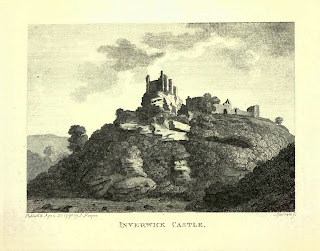On the coastal road from Edinburgh to North Berwick, just before Aberlady, you pass a long stone wall. A long stone wall that hides behind it the estate and gardens of Gosford House. I’ve cycled past here numerous times and have never paid much attention to it. Then last year, during the couple of weeks it is open to the public, I went on a guided tour of the house. Afterwards, I went on a quick wander around the gardens and thought I really should venture back some time to explore a bit more.
The
gardens, unlike the house, are open to the public for most of the year. However, you have to purchase a permit to
enter them. This probably puts a lot of
people off visiting, given how expensive it is at the massive cost of £1. But, hey, being free and easy with my cash I
thought nothing of forking that out for a visit and so headed off for a trek
around the estate.
Walking
along the woodland paths I spotted in the distance the rather grand pile that
is Gosford House. This was commissioned
in the 1790s by the Earl of Wemyss as a place to house his art collection and
impress his guests with. It was then built
on plans drawn up by the architect Robert Adam, who unfortunately died before
it was completed. Once the Earl had his
fancy new abode he needed some landscaping of the rather barren grounds that surrounded
it. The architect and landscaper, James
Ramsay was then employed to create a pleasure garden, and he did just that by creating
ponds, grottoes and woodland walks. So,
just like the house, the gardens were built to impress those who visited, and
they are still pretty impressive. There are
various rustic type buildings designed to give the gardens the look of an
eighteenth century landscape painting.
These include an icehouse and a boathouse, while there is also a rather
grand mausoleum with a pyramid roof.
The
woodland in the estate is one of these well managed places that seems like it
was always there. It almost feels that
the trees own the property especially when you come across some of the more
ancient ones with their twisted, heavy and ancient branches curling down to the
ground and up to the sky.
As
I walked around the estate it was bustling with wildlife. Numerous birds sang from the branches of the
trees, insects hummed, and small creatures scurried through the
undergrowth. By one of the ponds, I
watched as a goose taught her goslings to fly.
Skimming back and forwards the young ones followed her, flapping wildly. Nearby a serene looking heron stood still,
staring intently down at the water waiting to snatch a passing fish or two.
Further
around the pond I came to a rather kinky little building with tufa rockwork
walls, tufa being a soft and porous stone that was much favoured by the
Romans. The building was originally used
as a summerhouse for the pleasure gardens and probably had a thatched roof when
first built, but this was later replaced.
In the 1860s it acquired a function other than being a decorative and knobbly
little folly, when it became the base of the Aberlady Curling Club and was
converted into their Curling House. When the pond froze over, the club would
gather to play their games there and use the little house as a place to get
warm, and to store their curling stones and brushes.
Thankfully,
I was there on a lovely warm day, so rather than freezing my butt off I could
sit on a bench in the sunshine and watch the trees sway in a gentle summer
breeze. Looking over at the little
Curling House it had an almost fairytale quality, and I half expected some
character from the tales of the Brothers Grimm to come out and greet me. Though rather than a wolf in grandma’s
clothing or three hungry bears the only creature to come by was a large
dragonfly, who buzzed around busily and then shot away off over the pond.
After
catching the suns rays for more time than was really healthy, I left the
Skulferatu that had accompanied me on my walk in a hollow in one of the stones
of the Curling House wall.
The
coordinates for the location of the Skulferatu are -
I
used the following sources for information on the Curling House –




































































